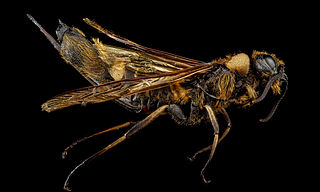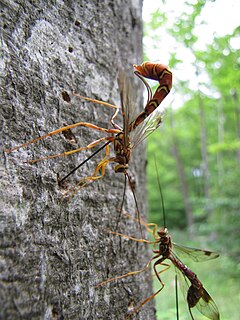Related Research Articles

Horntail or wood wasp is the common name for any of the 150 non-social species of the family Siricidae, of the order Hymenoptera, a type of xylophagous sawfly. This family was formerly believed to be the sole living representative of the superfamily Siricoidea, a group well represented in Paleogene and Mesozoic times, but the family Anaxyelidae has been linked to this group as well. Siricidae has two sub families, Siricinae and Tremecinae. Siricinae infest needle-leaved trees and Tremecinae infest broad-leaved trees. There are ten living genera placed in the family, and an additional three genera described from fossils. The last tergite of the abdomen has a strong, projecting spike, thus giving the group its common name. A typical adult horntail is brown, blue, or black with yellow parts, and may often reach up to 4 cm (1.6 in) long. The pigeon horntail can grow up to 5 cm (2.0 in) long, among the longest of all Hymenoptera.

The Xyelidae are a comparatively species-poor family of sawflies comprising about 80 extant species in five genera worldwide and is the only family in the superfamily Xyeloidea. The fossil record of the family is extensive, comprising more than 120 species and including the oldest fossil Hymenoptera species dating back to the Triassic, between 245 and 208 million years ago. Xyelidae are to be regarded as living fossils since they represent one of the oldest lineages of insects and include still extant forms.

Cerrena unicolor, commonly known as the mossy maze polypore, is a species of poroid fungus in the genus Cerrena. This saprobic fungus causes white rot.

A wasp is any insect of the narrow-waisted suborder Apocrita of the order Hymenoptera which is neither a bee nor an ant; this excludes the broad-waisted sawflies (Symphyta), which look somewhat like wasps but are in a separate suborder. The wasps do not constitute a clade, a complete natural group with a single ancestor, as their common ancestor is shared by bees and ants. Many wasps, those in the clade Aculeata, can sting their insect prey.

Tremex fuscicornis is a species of horntail, native to Europe and Asia, and has been introduced to Australia, Canada and Chile.

Tremex columba is a species of horntail, native to Eastern and Western North America. The females are larger than the males, with females growing to 25-30mm in length, and males about 20-25mm. The larvae feed on dead and dying trees such as beech, elm, maple, and oak.

Tremex is a genus of woodwasp in the Siricidae family. It has 33 species with a holarctic distribution. The larvae feed on hardwoods.
Tremex alchymista is a species of sawfly, native to Hungary and Romania.

The Ibaliidae are a small family of hymenopteran superfamily Cynipoidea. Ibaliidae differ from most of the cynipoids by the larvae being parasitoids on other wasp larvae in the group Siricidae. The Ibaliidae comprise three extant genera of fairly large wasps, with a total of 20 species, and is a sister group to the rest of the cynipoids except the small subfamily Austrocynipidae.

Megarhyssa atrata is a species of large ichneumon wasp. It is known from North America, where it is found from Quebec, Michigan, Ohio and North and South Carolina to Florida.

Megarhyssa macrurus, is a species of large ichneumon wasp.

Megalodontes cephalotes is a species of sawflies within the Symphyta belonging to the family Megalodontesidae.
References
| | This sawfly-related article is a stub. You can help Wikipedia by expanding it. |